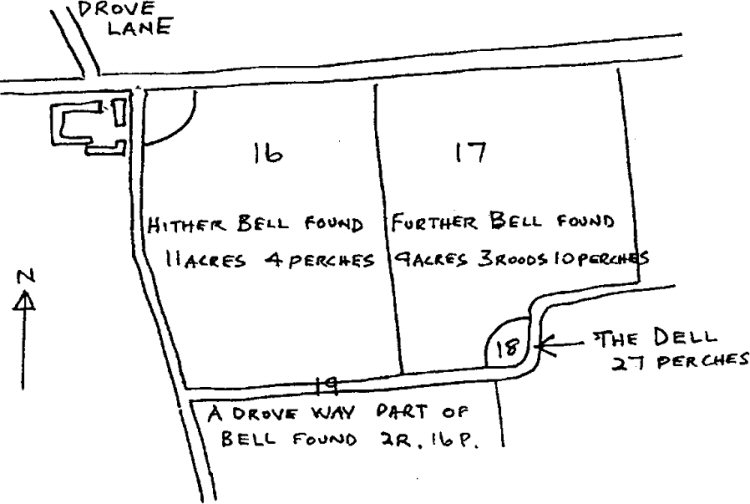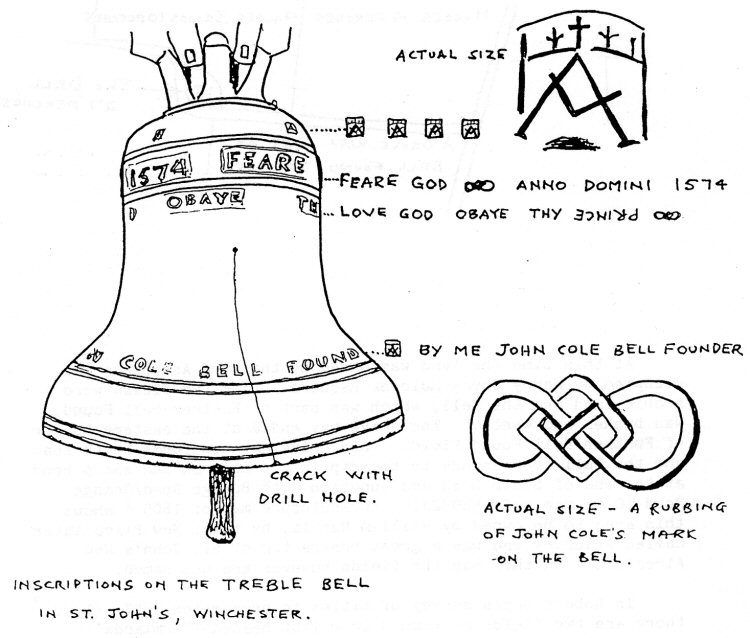BELL FOUNDING IN NEW ALRESFORD
The tithe map of New Alresford of 1842¹ shows areas numbered 16, 17, 18 and 19 named in the administration respectively as 'Hither Bell Found Field', 'Further Bell Found Field', 'A Dell' and a drove way, part of Bell Found.
SKETCH of 'TITHE- MAP of 1842

At this time the land was owned by the Lord Ashburton and occupied by Henry Joyce Mulcock Esquire. The two fields were arable land and the Dell, which was part of Further Bell Found, was bushes and waste. The drive way ended at the eastern border of Further Bell Found Field. This drive way now forms South Road and the Dell corresponds to the dip in the road on the sharp bend at the end of South Road and junction with Bridge Road/Grange Road (0.S. map ref. 580321). An enclosure map of 1805² shows this area to be owned by William Harris, he built New Place later called Arlebury and was a great benefactor of St. John's New Alresford. On this map the fields however are not named.
In Robert Boyes survey of titles to properties 1547 – 1730³ there are two fields mentioned in a list headed 'Farmlands' named West Bell Found 12 acres – 12 perches and East Bell Found 10 acres – 1 rood – 18 perches. The acreages roughly correspond to those of Hither and Further Bell Found fields so could possibly refer to the same area.
A modern geological map of the area shows small pockets of clay close by which was one of the materials used in the making of moulds for casting bells.
Although Alresford might not have had a factory type bell foundry it is possible that bells were cast in the area called the Dell by itinerant founders.
It is known that one such itinerant founder John Cole recast bells for St. John's Winchester in 1574. He is also known to have recast the tenor bell at Winchester College but this was again recast in 1673. The only remaining example of his work in Hampshire is in the tower of St. John's Winchester where the cracked treble bell is still hung in the tower but is un-ringable due to its condition.

The Rev. W.E. Colchester in his book
'Hampshire Bells' &sup4; indicates that the "A's" cast
in the crown of the St. John's treble bell
refer to Alresford, showing where the bell
was cast. However, of the few John Cole
bells remaining to this day (at Lindfield,
Findon, Tangmere Shadoxhurst and Orleston)
there are no such letters cast into their
crowns. Colchester speculates that the
Knot was John Coles mark - St. John's Winchester
account book for 1549-1596 &sup4; contains
many entries of charges and payments.
For the years 1573-1575, when John
Traves and William Assheborne were
church wardens, the following entries
on page 35 are of note :-
In the margin of the book beside the above entries is written :
pd to the belfounder for castyng the bell lijs (52s) pd for expenses at Alresford xxd (20d) pd to John Fawcett for caryage of the bell iijs viijd (3s8d)
Other entries on the same page.pd to ye, belfounder for casting (words crossed out & unreadable) bell (52s)
Jo : Colle
for fyve belropes 8s
for ringing for the queen 18d
A.D. Tyssen in his book Church Bells of Sussex published 1864 &sup6; speculates from evidence in these accounts that John Cole either lived in Alresford or was on the road to it. It is difficult to prove that John Cole did live in Alresford as the parish registers for that time do not exist presumably destroyed in the fire of 1689 or in 1678 when the parish clerk's house was burnt down.
Perhaps John Cole was recasting bells for St. John's New Alresford at this time, as Rev Colchester suggests, so that it was convenient to do other work at what was presumably a convenient site. Although there seems to be no firm evidence that the Dell was the site of the 1574 casting of the St. John's Winchester and the College bells it does seem logical in the light of subsequent findings.
More definitive evidence of the use of this site for bell casting can be found in the transcript of Upham Parish Registers.&sup7; In the front of this small green leather covered book is a list of the weights for Upham bells and written underneath is :-
"Cast in a field (or large Dell) near Alresford by Mr. Thos. Swaine".The oldest six bells at Upham have as well as other inscriptions the following :
"Thos. Swain (made us all) 1761".Upham is now a ring of eight bells, two additional bells having been added in recent years.
Thomas Swain is known to have taken over the Robert Catlin's foundry at Holborn in 1751; later working from Longford Middlesex until 1781. Although Swain had a factory (foundry) in London it is possible that he did do itinerant work and cast Upham bells in Alresford, perhaps doing work on St. John's New Alresford bells but there is no record of this work.
The Alresford Displayed working party in their Issue No. 4 (1980) Paper No. 14, speculates a connection between Arthur Swain owning property at Alresford in 1588 and Thomas Swain the founder of Upham bells.
©Elizabeth Johnson, 1995
SOURCES :1 HRO 21 M65/F7/167/3 Map. 21 M65/F7/167/1 Administration.
2 HRO 7 M50/13 copy Map.
3 HRO 45 M83/PZ1 Survey and Account of Titles in New Alresford.
4 Hampshire Church Bells; Their Founders and Inscriptions W.E. Colchester 1920.
5 HRO 88 M81/W/PW1.
6 The Church Bells of Sussex by A.D. Tyssen 1864.
7 HRO 74 M78/PZl transcript of Upham Parish Registers.
Writer's footnote :
The method of producing bells has changed little in over four centuries. An inner mould or "core" defines the hollow part of the bell, the outer mould or "cope" defines the external shape of the bell. By pouring molten metal (an alloy of Copper 77% and Tin 23%) into the space left between the two moulds the bell is formed.
The core is made by carefully smoothing loam over a brick or stone rubble base. The cope is formed by smoothing loan onto the inside of a perforated metal bell shaped case. The accurate profiles needed are obtained by passing shaped gauges or "strickles" over the loam covered moulds.
Inscriptions are impressed into the inside surface of the cope so as to appear on the outside of the finished bell.
The two moulds are fitted together onto a base plate and lowered into a pit, mouth down, ready to receive the molten metal via a hole in the top of the cope.
Before 1300 the metal would have been melted in an open crucible, later simple reverberatory furnaces would have been used. The itinerant founders would have constructed temporary furnaces at suitable sites, using local materials to build the hearth for melting the metal and the domed roof over to contain the heat from a charcoal or timber fire.
It is remnants of these furnaces, the broken baked clay moulds and fragments of metal dross, that could be found at the sites of these temporary foundries.